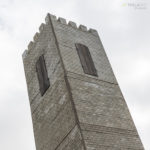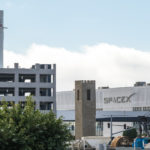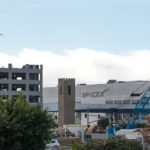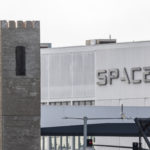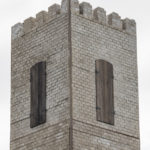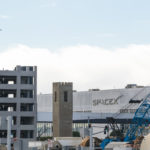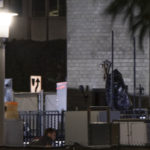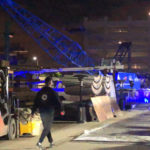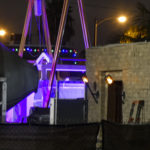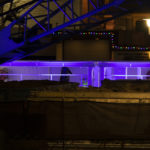
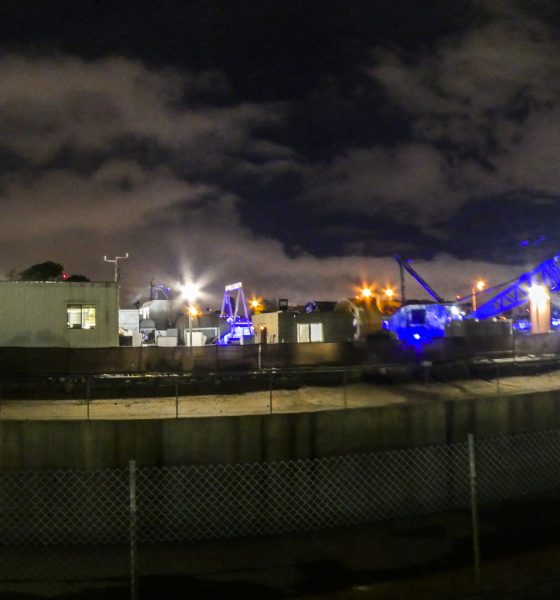
News
The Boring Company event sneak peak: venue, tunneling machine, completed watchtower
After months of operating underground, The Boring Company is coming to the surface with the unveiling event of its test tunnel in Hawthorne, CA. The Boring Company is set to livestream Tuesday’s opening party, as Elon Musk presents what could very well be the first step towards a future connected with ultra-high-speed tunnels.
The Boring Company’s tunnel unveiling event is poised to feature a lot of fun, lighthearted activities, as represented by the multi-story medieval watchtower constructed on the opening party’s venue. The idea of the watchtower came from one of Elon Musk’s playful Twitter sessions, where he announced that the tunneling startup would be building a watchtower on the Los Angeles site, where a person dressed as a knight would be tasked to “yell insults at people in a French accent” to passers-by — a reference to one of the most memorable scenes in the classic comedy film Monty Python and the Holy Grail.
- The Boring Company’s completed watchtower. (Photo: Pauline Acalin/Teslarati)
- The Boring Company’s completed watchtower. (Photo: Pauline Acalin/Teslarati)
- The Boring Company’s completed watchtower. (Photo: Pauline Acalin/Teslarati)
- The Boring Company’s completed watchtower. (Photo: Pauline Acalin/Teslarati)
- The Boring Company’s completed watchtower. (Photo: Pauline Acalin/Teslarati)
- The Boring Company’s completed watchtower. (Photo: Pauline Acalin/Teslarati)
- The Boring Company’s completed watchtower. (Photo: Pauline Acalin/Teslarati)
- The Boring Company’s completed watchtower. (Photo: Pauline Acalin/Teslarati)
- The Boring Company’s completed watchtower. (Photo: Pauline Acalin/Teslarati)
The Boring Company’s completed watchtower. (Photo: Pauline Acalin/Teslarati)
The watchtower was constructed in a quick and clever manner, with the Boring Co. utilizing a metal framework overlaid with pre-made sections of Boring Bricks. Teslarati photographer Pauline Acalin has followed the tower’s construction over the past couple of weeks, and returning to the site on Monday, she was able to capture images of a fully-constructed watchtower, complete with wooden window shutters and more refined brickwork.
Driving by the site on Monday night, Pauline and fellow Teslarati photographer Tom Cross were able to capture more images of the opening party’s venue. Pictures and video taken of the site reveal that The Boring Company is already setting up the lights and the sound system for the event. Some details of Elon Musk’s completed Monty Python-style watchtower, such as torches on both sides of the structure’s wooden doors, could also be seen. Furthermore, The Boring Company appears to have laid some accent lighting on a tunnel boring machine currently under construction, which is set to be utilized for its high-profile Chicago tunneling project.
- The Boring Company’s next-gen TBM, which appears to be under construction, is highlighted with some accent lighting. (Photo: Tom Cross/Teslarati)
- The venue for The Boring Company’s opening event on Tuesday, December 18, 2018. (Photo: Tom Cross/Teslarati)
- The venue for The Boring Company’s opening event on Tuesday, December 18, 2018. (Photo: Tom Cross/Teslarati)
- The venue for The Boring Company’s opening event on Tuesday, December 18, 2018. (Photo: Tom Cross/Teslarati)
- Torches invoke an air of Elon Musk’s “Medieval Futurism” on the site of the TBC opening party. (Photo: Tom Cross/Teslarati)
- The venue for The Boring Company’s opening event on Tuesday, December 18, 2018. (Photo: Tom Cross/Teslarati)
- The venue for The Boring Company’s opening event on Tuesday, December 18, 2018. (Photo: Tom Cross/Teslarati)
The venue for The Boring Company’s opening event on Tuesday, December 18, 2018. (Photo: Tom Cross/Teslarati)
The Boring Company’s test tunnel unveiling event on Tuesday stands as a milestone for the young startup. Elon Musk, for one, noted in a tweet earlier this month that the December 18 product launch will be “more than a tunnel opening.” Seemingly teasing some progress on a garage-elevator concept that the company is building near the SpaceX headquarters, Musk also stated that the event would “include modded but fully road legal autonomous transport cars & ground to tunnel car elevators.” Free test rides would be offered to the public after the tunnel unveiling event as well.
While The Boring Company is considered more as one of Elon Musk’s more fun hobbies, the startup has been extending its reach nonetheless. The company, for one, beat out more experienced rivals when it was selected to construct a high-speed transport line that would connect downtown Chicago to O’Hare airport. Recent permits from Hawthorne also reveal that The Boring Company is opening The Brick Store, a physical location that will sell Boring Bricks, which could be used for fun projects or low-cost construction and are made from tunneling rock.
Be sure to follow along on Twitter as we take you behind the scenes at The Company unveiling. For now, enjoy this 6-minute footage from Tom and Pauline as they scouted the site of tonight’s opening party.
https://twitter.com/_TomCross_/status/1074869183454691329

Elon Musk
Elon Musk and Tesla AI Director share insights after empty driver seat Robotaxi rides
The executives’ unoccupied tests hint at the rapid progress of Tesla’s unsupervised Robotaxi efforts.

Tesla CEO Elon Musk and AI Director Ashok Elluswamy celebrated Christmas Eve by sharing personal experiences with Robotaxi vehicles that had no safety monitor or occupant in the driver’s seat. Musk described the system’s “perfect driving” around Austin, while Elluswamy posted video from the back seat, calling it “an amazing experience.”
The executives’ unoccupied tests hint at the rapid progress of Tesla’s unsupervised Robotaxi efforts.
Elon and Ashok’s firsthand Robotaxi insights
Prior to Musk and the Tesla AI Director’s posts, sightings of unmanned Teslas navigating public roads were widely shared on social media. One such vehicle was spotted in Austin, Texas, which Elon Musk acknowleged by stating that “Testing is underway with no occupants in the car.”
Based on his Christmas Eve post, Musk seemed to have tested an unmanned Tesla himself. “A Tesla with no safety monitor in the car and me sitting in the passenger seat took me all around Austin on Sunday with perfect driving,” Musk wrote in his post.
Elluswamy responded with a 2-minute video showing himself in the rear of an unmanned Tesla. The video featured the vehicle’s empty front seats, as well as its smooth handling through real-world traffic. He captioned his video with the words, “It’s an amazing experience!”
Towards Unsupervised operations
During an xAI Hackathon earlier this month, Elon Musk mentioned that Tesla owed be removing Safety Monitors from its Robotaxis in Austin in just three weeks. “Unsupervised is pretty much solved at this point. So there will be Tesla Robotaxis operating in Austin with no one in them. Not even anyone in the passenger seat in about three weeks,” he said. Musk echoed similar estimates at the 2025 Annual Shareholder Meeting and the Q3 2025 earnings call.
Considering the insights that were posted Musk and Elluswamy, it does appear that Tesla is working hard towards operating its Robotaxis with no safety monitors. This is quite impressive considering that the service was launched just earlier this year.
Elon Musk
Starlink passes 9 million active customers just weeks after hitting 8 million
The milestone highlights the accelerating growth of Starlink, which has now been adding over 20,000 new users per day.

SpaceX’s Starlink satellite internet service has continued its rapid global expansion, surpassing 9 million active customers just weeks after crossing the 8 million mark.
The milestone highlights the accelerating growth of Starlink, which has now been adding over 20,000 new users per day.
9 million customers
In a post on X, SpaceX stated that Starlink now serves over 9 million active users across 155 countries, territories, and markets. The company reached 8 million customers in early November, meaning it added roughly 1 million subscribers in under seven weeks, or about 21,275 new users on average per day.
“Starlink is connecting more than 9M active customers with high-speed internet across 155 countries, territories, and many other markets,” Starlink wrote in a post on its official X account. SpaceX President Gwynne Shotwell also celebrated the milestone on X. “A huge thank you to all of our customers and congrats to the Starlink team for such an incredible product,” she wrote.
That growth rate reflects both rising demand for broadband in underserved regions and Starlink’s expanding satellite constellation, which now includes more than 9,000 low-Earth-orbit satellites designed to deliver high-speed, low-latency internet worldwide.
Starlink’s momentum
Starlink’s momentum has been building up. SpaceX reported 4.6 million Starlink customers in December 2024, followed by 7 million by August 2025, and 8 million customers in November. Independent data also suggests Starlink usage is rising sharply, with Cloudflare reporting that global web traffic from Starlink users more than doubled in 2025, as noted in an Insider report.
Starlink’s momentum is increasingly tied to SpaceX’s broader financial outlook. Elon Musk has said the satellite network is “by far” the company’s largest revenue driver, and reports suggest SpaceX may be positioning itself for an initial public offering as soon as next year, with valuations estimated as high as $1.5 trillion. Musk has also suggested in the past that Starlink could have its own IPO in the future.
News
NVIDIA Director of Robotics: Tesla FSD v14 is the first AI to pass the “Physical Turing Test”
After testing FSD v14, Fan stated that his experience with FSD felt magical at first, but it soon started to feel like a routine.

NVIDIA Director of Robotics Jim Fan has praised Tesla’s Full Self-Driving (Supervised) v14 as the first AI to pass what he described as a “Physical Turing Test.”
After testing FSD v14, Fan stated that his experience with FSD felt magical at first, but it soon started to feel like a routine. And just like smartphones today, removing it now would “actively hurt.”
Jim Fan’s hands-on FSD v14 impressions
Fan, a leading researcher in embodied AI who is currently solving Physical AI at NVIDIA and spearheading the company’s Project GR00T initiative, noted that he actually was late to the Tesla game. He was, however, one of the first to try out FSD v14.
“I was very late to own a Tesla but among the earliest to try out FSD v14. It’s perhaps the first time I experience an AI that passes the Physical Turing Test: after a long day at work, you press a button, lay back, and couldn’t tell if a neural net or a human drove you home,” Fan wrote in a post on X.
Fan added: “Despite knowing exactly how robot learning works, I still find it magical watching the steering wheel turn by itself. First it feels surreal, next it becomes routine. Then, like the smartphone, taking it away actively hurts. This is how humanity gets rewired and glued to god-like technologies.”
The Physical Turing Test
The original Turing Test was conceived by Alan Turing in 1950, and it was aimed at determining if a machine could exhibit behavior that is equivalent to or indistinguishable from a human. By focusing on text-based conversations, the original Turing Test set a high bar for natural language processing and machine learning.
This test has been passed by today’s large language models. However, the capability to converse in a humanlike manner is a completely different challenge from performing real-world problem-solving or physical interactions. Thus, Fan introduced the Physical Turing Test, which challenges AI systems to demonstrate intelligence through physical actions.
Based on Fan’s comments, Tesla has demonstrated these intelligent physical actions with FSD v14. Elon Musk agreed with the NVIDIA executive, stating in a post on X that with FSD v14, “you can sense the sentience maturing.” Musk also praised Tesla AI, calling it the best “real-world AI” today.
